Mechanical Properties of Polypropylene Fiber Cement Mortar under Different Loading Speeds
Abstract
1. Introduction
2. Experimental Program
2.1. Raw Materials and Mixture Design
2.2. Sample Preparation
2.3. Test Setup
3. Results and Discussion
3.1. Compressive Strength and Flexural Strength Test Results
3.2. The Influence of Loading Speed on the Mechanical Tests Results
3.3. The Influence of PPF Content on the Mechanical Test Results
3.4. Analytical Model for the Compressive Strength Prediction of PPF Mortar under Different Loading Speeds
3.5. Analytical Model for Flexural Strength Prediction of PPF Mortar under Different Loading Speeds
4. Conclusions
- The incorporation of PPF can improve the compressive and flexural strength of cement mortar at early ages, and the improvement can be attributed to the interaction between the fiber and cement mortar matrix.
- A higher test loading speed results in higher compressive and flexural strength, and linear relationships can be observed between the loading speed and the strength test results.
- The proposed models can be used to predict the compressive and flexural strength of PPF-incorporated cement mortar under different loading speeds. Of the predicted compressive strength results, 70.4% showed less than a 15% relative error compared with the experimental results, while for the predicted flexural strength results, it was 75.9%.
Author Contributions
Funding
Institutional Review Board Statement
Informed Consent Statement
Data Availability Statement
Conflicts of Interest
References
- He, R.; Ma, H.; Hafiz, R.B.; Fu, C.; Jin, X.; He, J. Determining porosity and pore network connectivity of cement-based materials by a modified non-contact electrical resistivity measurement: Experiment and theory. Mater. Des. 2018, 156, 82–92. [Google Scholar] [CrossRef]
- Ramezanianpour, A.M.; Hooton, R.D. A study on hydration, compressive strength, and porosity of Portland-limestone cement mixes containing SCMs. Cem. Concr. Compos. 2014, 51, 1–13. [Google Scholar] [CrossRef]
- He, R.; Ye, H.; Ma, H.; Fu, C.; Jin, X.; Li, Z. Correlating the Chloride Diffusion Coefficient and Pore Structure of Cement-Based Materials Using Modified Noncontact Electrical Resistivity Measurement. J. Mater. Civ. Eng. 2019, 31, 04019006. [Google Scholar] [CrossRef]
- Ye, H.; Jin, N.; Jin, X.; Fu, C.; Chen, W. Chloride ingress profiles and binding capacity of mortar in cyclic drying-wetting salt fog environments. Constr. Build. Mater. 2016, 127, 733–742. [Google Scholar] [CrossRef]
- He, R.; Fu, C.; Ma, H.; Ye, H.; Jin, X. Prediction of Effective Chloride Diffusivity of Cement Paste and Mortar from Microstructural Features. J. Mater. Civ. Eng. 2020, 32, 04020211. [Google Scholar] [CrossRef]
- Chen, J.; Wang, J.; He, R.; Shu, H.; Fu, C. Experimental Study on Effective Chloride Diffusion Coefficient of Cement Mortar by Different Electrical Accelerated Measurements. Crystals 2021, 11, 240. [Google Scholar] [CrossRef]
- Fu, C.; Ling, Y.; Wang, K. An innovation study on chloride and oxygen diffusions in simulated interfacial transition zone of cementitious material. Cem. Concr. Compos. 2020, 110, 103585. [Google Scholar] [CrossRef]
- Mohammadhosseini, H.; Alyousef, R.; Tahir, M.M. Towards Sustainable Concrete Composites through Waste Valorisation of Plastic Food Trays as Low-Cost Fibrous Materials. Sustainability 2021, 13, 2073. [Google Scholar] [CrossRef]
- Merta, I.; Tschegg, E. Fracture energy of natural fibre reinforced concrete. Constr. Build. Mater. 2013, 40, 991–997. [Google Scholar] [CrossRef]
- Shen, D.; Jiao, Y.; Gao, Y.; Zhu, S.; Jiang, G. Influence of ground granulated blast furnace slag on cracking potential of high performance concrete at early age. Constr. Build. Mater. 2020, 241, 117839. [Google Scholar] [CrossRef]
- Shen, D.; Liu, C.; Feng, Z.; Zhu, S.; Liang, C. Influence of ground granulated blast furnace slag on the early-age anti-cracking property of internally cured concrete. Constr. Build. Mater. 2019, 223, 233–243. [Google Scholar] [CrossRef]
- Lehner, P.; Konečný, P.; Ponikiewski, T. Comparison of Material Properties of SCC Concrete with Steel Fibres Related to Ingress of Chlorides. Crystals 2020, 10, 220. [Google Scholar] [CrossRef]
- Yew, M.K.; Bin Mahmud, H.; Shafigh, P.; Ang, B.C. Effects of polypropylene twisted bundle fibers on the mechanical properties of high-strength oil palm shell lightweight concrete. Mater. Struct. 2015, 49, 1221–1233. [Google Scholar] [CrossRef]
- Prescient & Strategic Intelligence, Polypropylene Market Research Report: By Type, Application, End Use—Global Industry Analysis and Demand Forecast to 2030, Global. 2020. Available online: https://www.researchandmarkets.com/reports/5184632/polypropylene-market-research-report-by-type?utm_source=CI&utm_medium=PressRelease&utm_code=6lvqdn&utm_campaign=1491061+-+Global+Polypropylene+Markets%2C+2019-2020+%26+2030+-+Increasing+Use+in+Packaging+Industry+%26+Growing+Nonwoven+Polypropylene+Fiber+Industry&utm_exec=chdo54prd (accessed on 24 March 2021).
- Badogiannis, E.; Christidis, K.; Tzanetatos, G. Evaluation of the mechanical behavior of pumice lightweight concrete reinforced with steel and polypropylene fibers. Constr. Build. Mater. 2019, 196, 443–456. [Google Scholar] [CrossRef]
- Wang, D.; Ju, Y.; Shen, H.; Xu, L. Mechanical properties of high performance concrete reinforced with basalt fiber and polypropylene fiber. Constr. Build. Mater. 2019, 197, 464–473. [Google Scholar] [CrossRef]
- Mohseni, E.; Khotbehsara, M.M.; Naseri, F.; Monazami, M.; Sarker, P. Polypropylene fiber reinforced cement mortars containing rice husk ash and nano-alumina. Constr. Build. Mater. 2016, 111, 429–439. [Google Scholar] [CrossRef]
- Turba, Y.; Solodkyy, S. Crack Resistance of Concretes Reinforced with Polypropylene Fiber. In Proceedings of the Lecture Notes in Civil Engineering; Metzler, J.B., Ed.; Springer: Cham, Switzerland, 2020; pp. 474–481. [Google Scholar]
- Shen, D.; Liu, X.; Zeng, X.; Zhao, X.; Jiang, G. Effect of polypropylene plastic fibers length on cracking resistance of high performance concrete at early age. Constr. Build. Mater. 2020, 244, 117874. [Google Scholar] [CrossRef]
- Shen, D.; Liu, C.; Li, C.; Zhao, X.; Jiang, G. Influence of Barchip fiber length on early-age behavior and cracking resistance of concrete internally cured with super absorbent polymers. Constr. Build. Mater. 2019, 214, 219–231. [Google Scholar] [CrossRef]
- Sachet, W.H.; Salman, W.D. Compressive Strength Development of Slag-Based Geopolymer Paste Reinforced with Fibers Cured at Ambient Condition. In Proceedings of IOP Conference Series: Materials Science and Engineering, Thi-Qar, Iraq, 15–16 July 2020; 16 July 2020. [Google Scholar]
- Guo, X.; Xiong, G. Resistance of fiber-reinforced fly ash-steel slag based geopolymer mortar to sulfate attack and drying-wetting cycles. Constr. Build. Mater. 2021, 269, 121326. [Google Scholar] [CrossRef]
- Karahan, O.; Atiş, C.D. The durability properties of polypropylene fiber reinforced fly ash concrete. Mater. Des. 2011, 32, 1044–1049. [Google Scholar] [CrossRef]
- Mohammadhosseini, H.; Alrshoudi, F.; Tahir, M.M.; Alyousef, R.; Alghamdi, H.; Alharbi, Y.R.; Alsaif, A. Performance evaluation of novel prepacked aggregate concrete reinforced with waste polypropylene fibers at elevated temperatures. Constr. Build. Mater. 2020, 259, 120418. [Google Scholar] [CrossRef]
- Nuaklong, P.; Boonchoo, N.; Jongvivatsakul, P.; Charinpanitkul, T.; Sukontasukkul, P. Hybrid effect of carbon nanotubes and polypropylene fibers on mechanical properties and fire resistance of cement mortar. Constr. Build. Mater. 2021, 275, 122189. [Google Scholar] [CrossRef]
- Medina, N.F.; Barluenga, G.; Hernández-Olivares, F. Enhancement of durability of concrete composites containing natural pozzolans blended cement through the use of Polypropylene fibers. Compos. Part B Eng. 2014, 61, 214–221. [Google Scholar] [CrossRef]
- Grote, D.; Park, S.; Zhou, M. Dynamic behavior of concrete at high strain rates and pressures: I. experimental characterization. Int. J. Impact Eng. 2001, 25, 869–886. [Google Scholar] [CrossRef]
- Xu, Z.; Hao, H.; Li, H. Experimental study of dynamic compressive properties of fibre reinforced concrete material with different fibres. Mater. Des. 2012, 33, 42–55. [Google Scholar] [CrossRef]
- Zhang, M.; Wu, H.; Li, Q.; Huang, F. Further investigation on the dynamic compressive strength enhancement of concrete-like materials based on split Hopkinson pressure bar tests. Part I: Experiments. Int. J. Impact Eng. 2009, 36, 1327–1334. [Google Scholar] [CrossRef]
- Fischer, I.; Pichler, B.; Lach, E.; Terner, C.; Barraud, E.; Britz, F. Compressive strength of cement paste as a function of loading rate: Experiments and engineering mechanics analysis. Cem. Concr. Res. 2014, 58, 186–200. [Google Scholar] [CrossRef]
- Abrams, D.A. Effect of rate of application of load on the compressive strength of concrete. Proceeding ASTM 1917, 17, 364–377. [Google Scholar]
- Bischoff, P.H.; Perry, S.H. Compressive behaviour of concrete at high strain rates. Mater. Struct. 1991, 24, 425–450. [Google Scholar] [CrossRef]
- Gary, G.; Bailly, P. Behaviour of quasi-brittle material at high strain rate. Experiment and modelling. Eur. J. Mech. A Solids 1998, 17, 403–420. [Google Scholar] [CrossRef]
- Kaplan, S.A. Factors affecting the relationship between rate of loading and measured compressive strength of concrete. Mag. Concr. Res. 1980, 32, 79–88. [Google Scholar] [CrossRef]
- Fu, H.C.; Erki, M.A.; Seckin, M. Review of Effects of Loading Rate on Concrete in Compression. J. Struct. Eng. 1991, 117, 3645–3659. [Google Scholar] [CrossRef]
- GB 175-2007. Common Portland Cements, Chinese Natl. Stand. 2019. Available online: https://www.codeofchina.com/standard/GB175-2007.html (accessed on 24 March 2021).
- Song, P.; Hwang, S.; Sheu, B. Strength properties of nylon- and polypropylene-fiber-reinforced concretes. Cem. Concr. Res. 2005, 35, 1546–1550. [Google Scholar] [CrossRef]
- ACI Committee 209, Prediction of Creep, Shrinkage, and Temperature Effects in Concrete Structures (Reapproved 2008). 2002. Available online: https://www.concrete.org/store/productdetail.aspx?ItemID=20992&Format=DOWNLOAD&Language=English&Units=US_AND_METRIC (accessed on 24 March 2021).
- Ceb-Fip Model Code 1990, 1993: Design Code; Telford: London, UK, 1993. [CrossRef]
- Design Provisions for Drying Shrinkage and Creep of Normal-Strength Concrete. ACI Mater. J. 2001, 98. [CrossRef]
- Vipulanandan, C.; Mohammed, A.S. Smart cement modified with iron oxide nanoparticles to enhance the piezoresistive behavior and compressive strength for oil well applications. Smart Mater. Struct. 2015, 24, 125020. [Google Scholar] [CrossRef]
- Vipulanandan, C.; Mohammed, A. New Vipulanandan Failure Model and Property Correlations for Sandstone. Shale Limest. Rocks 2018. [Google Scholar] [CrossRef]
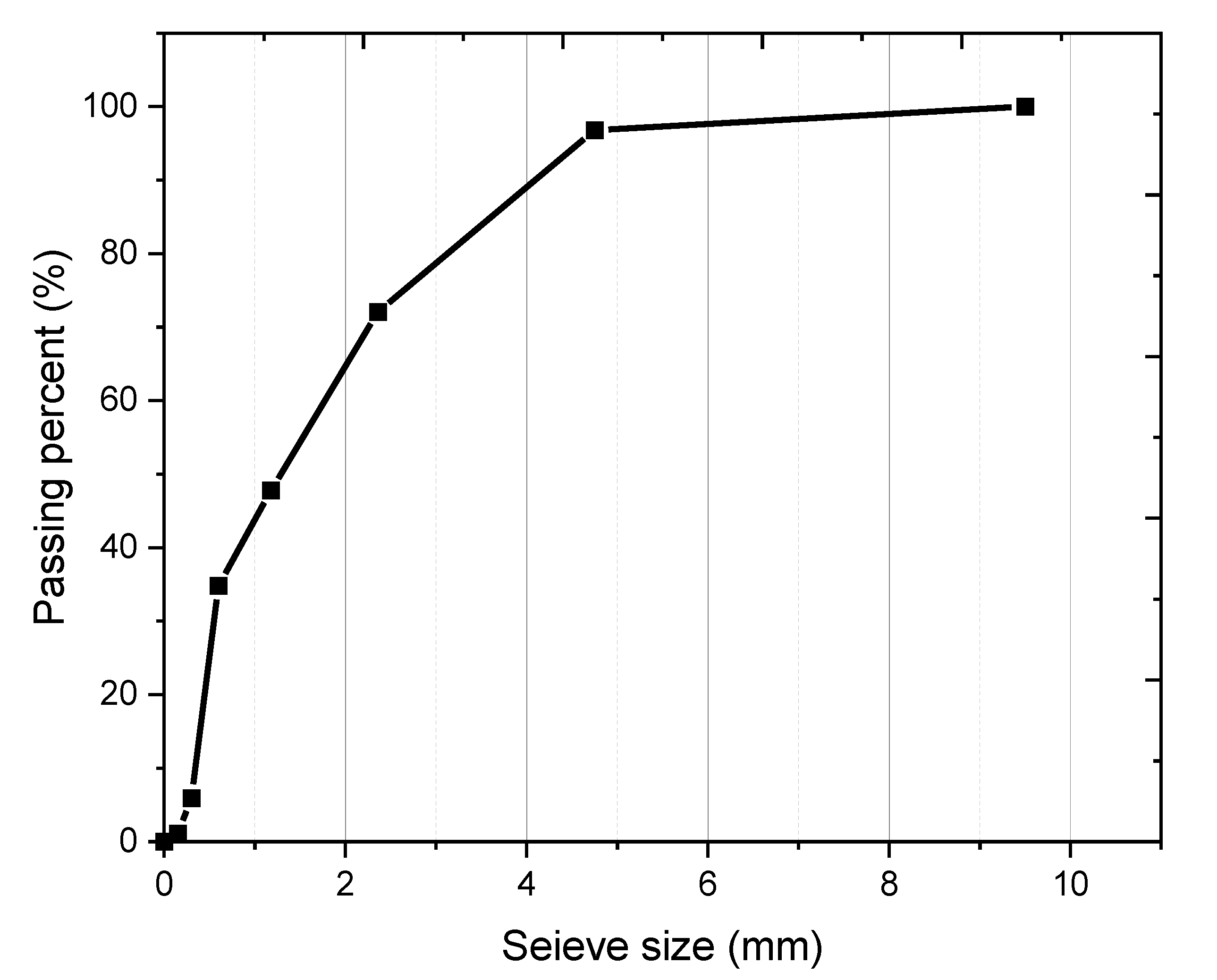
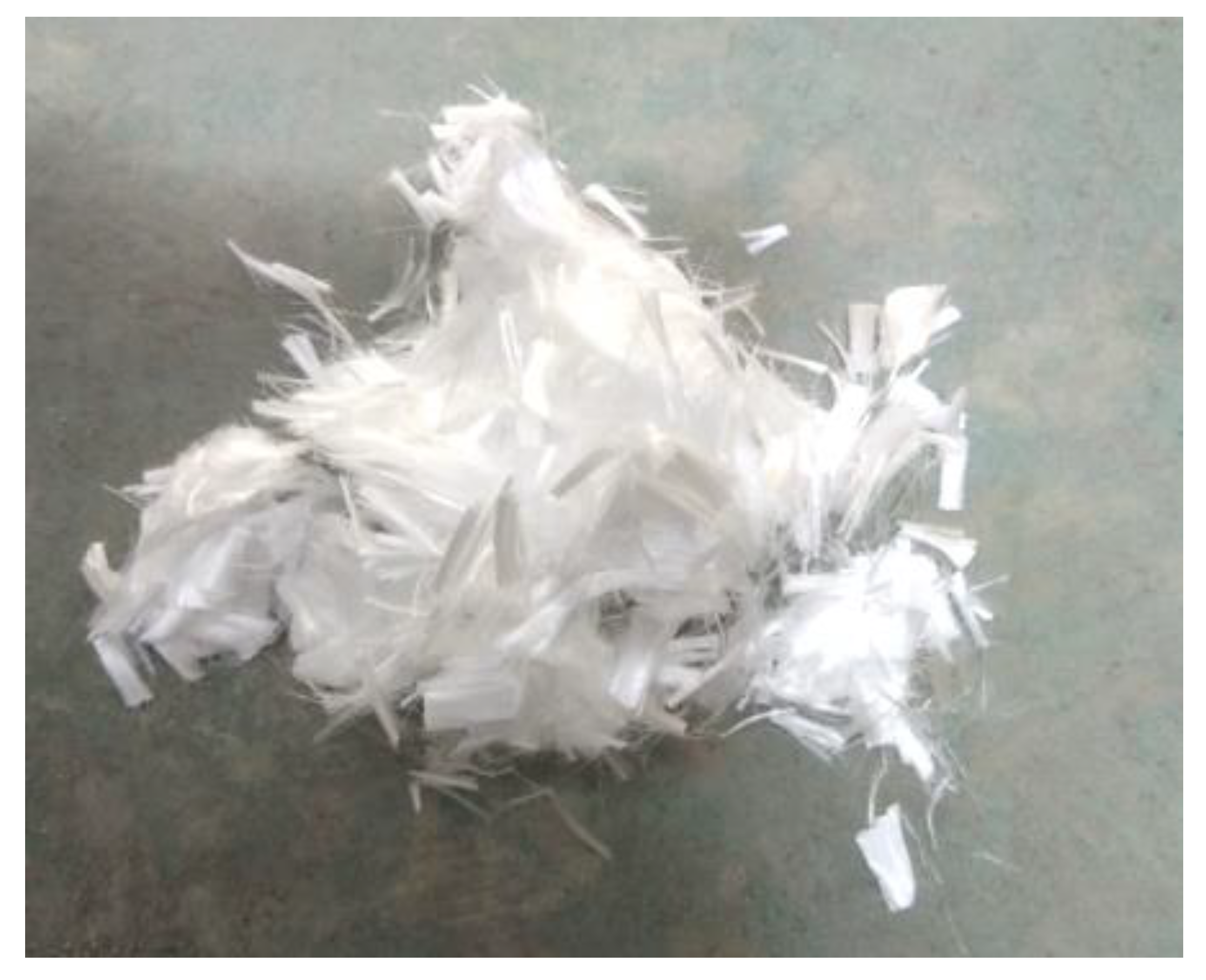

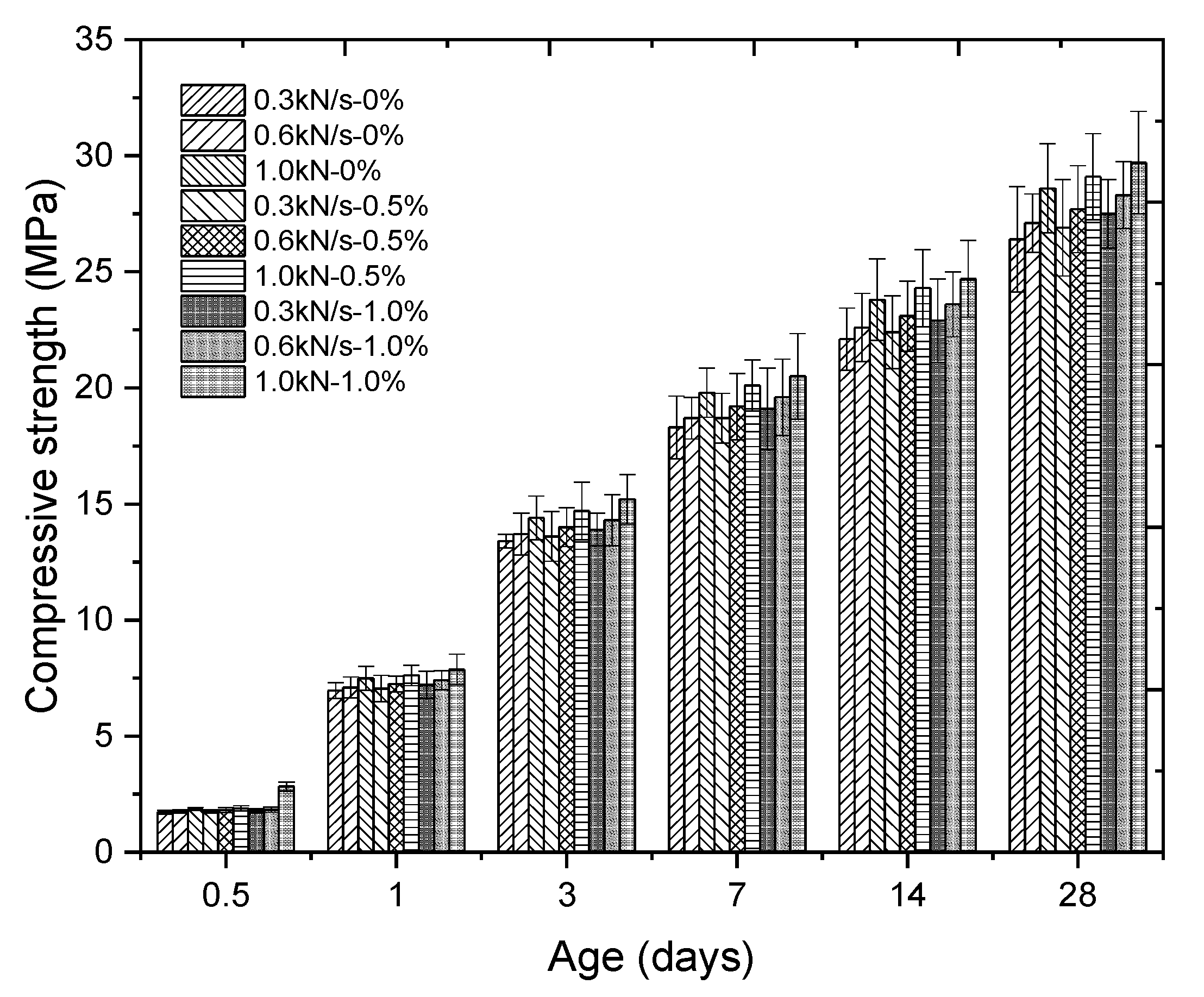


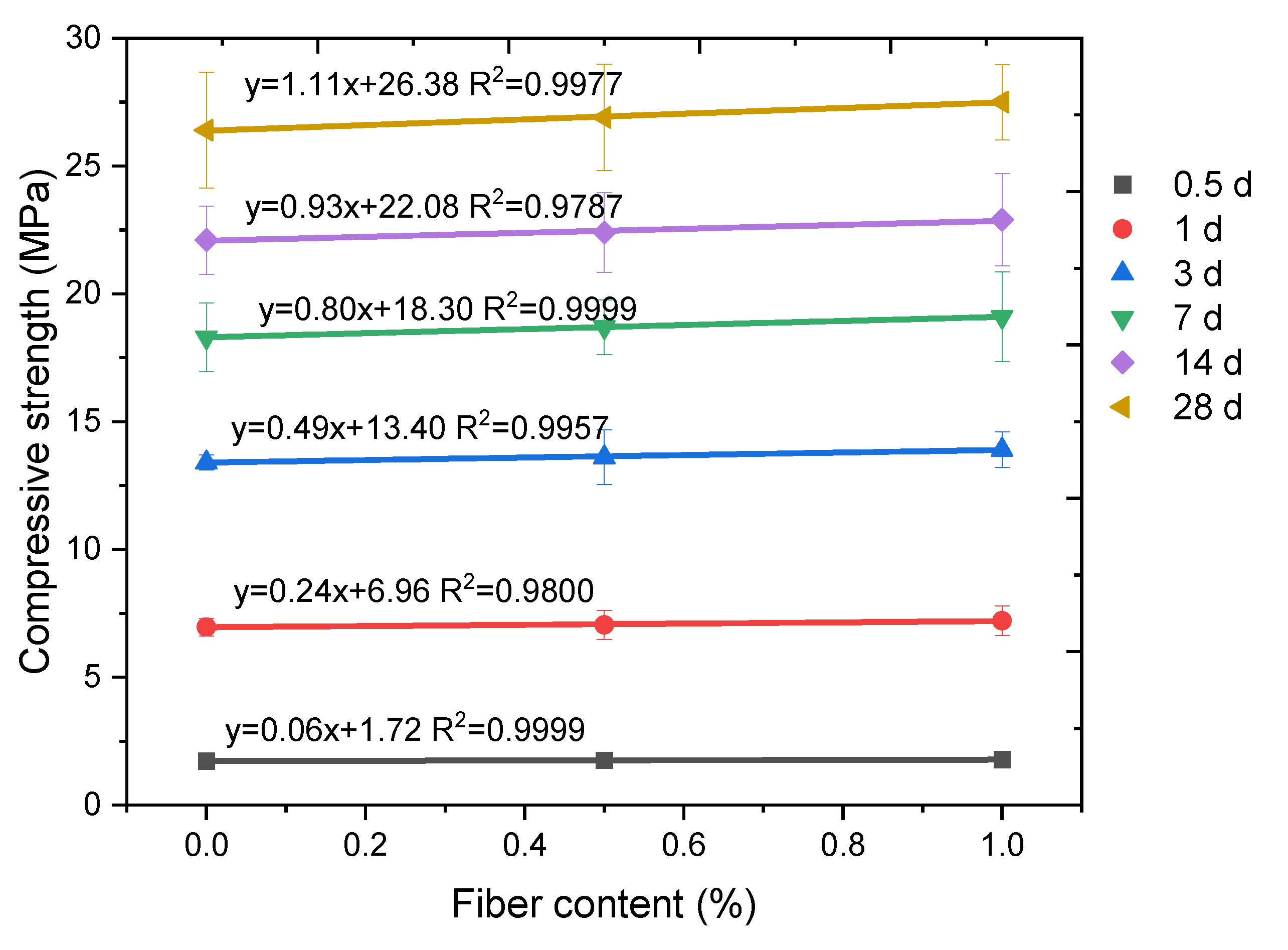

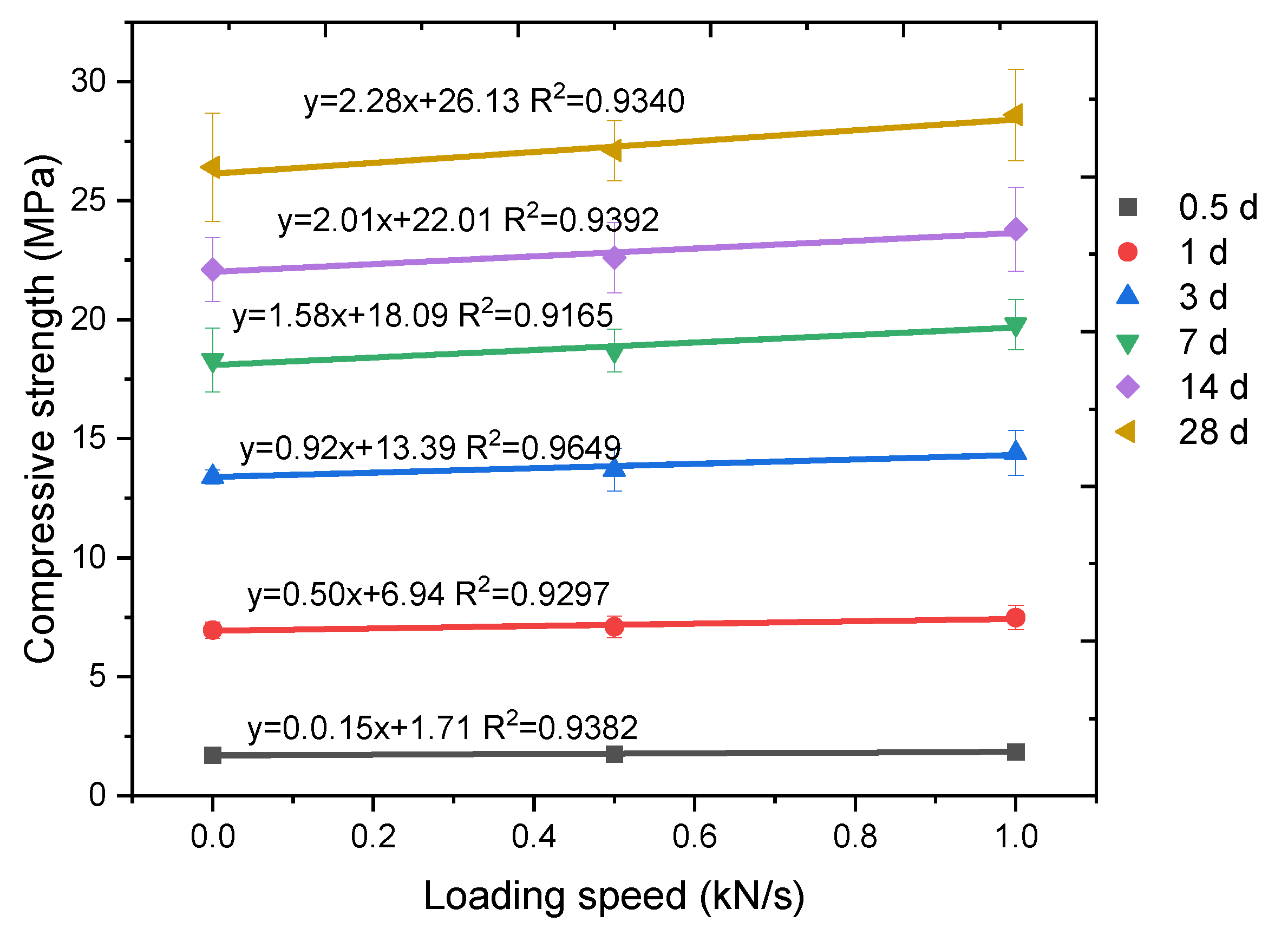



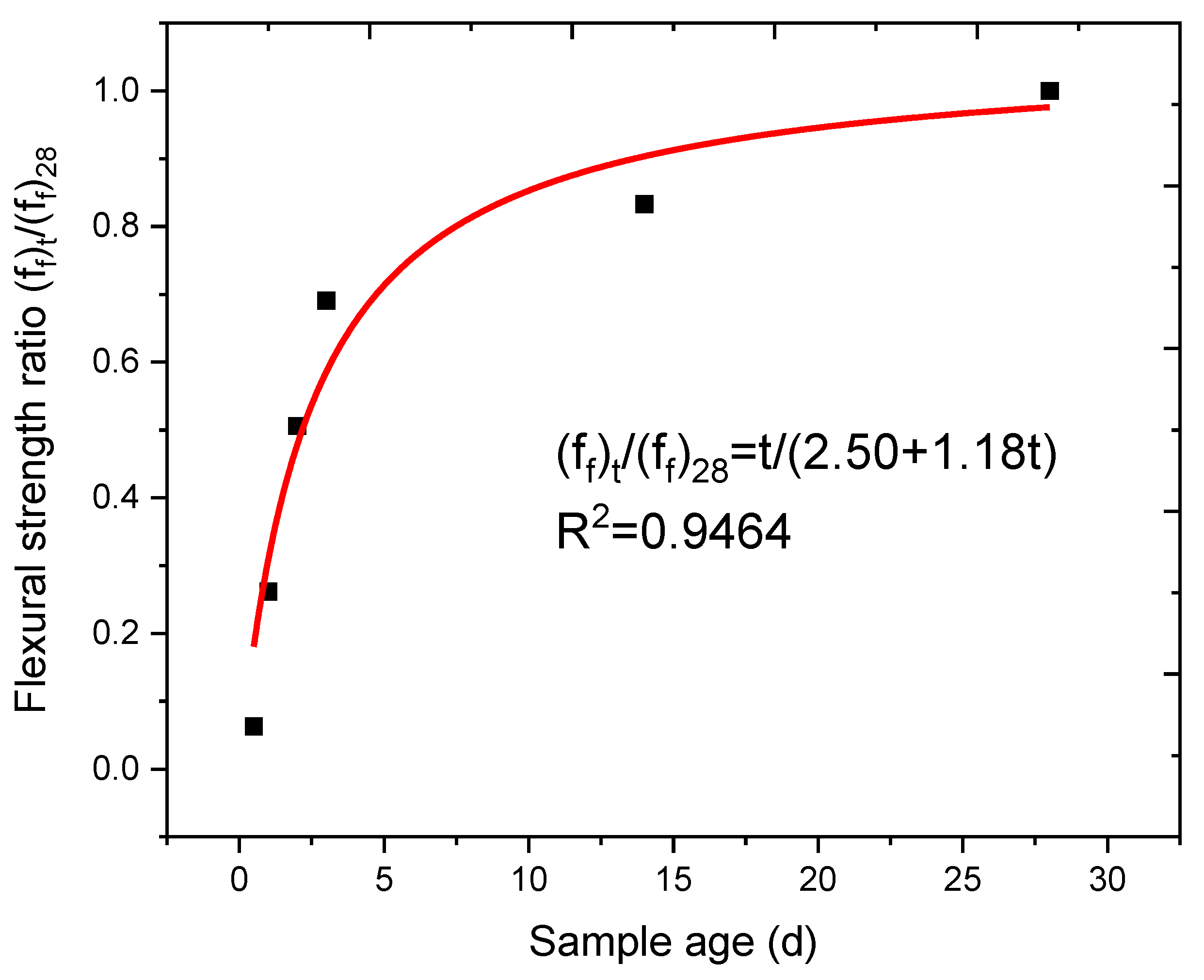

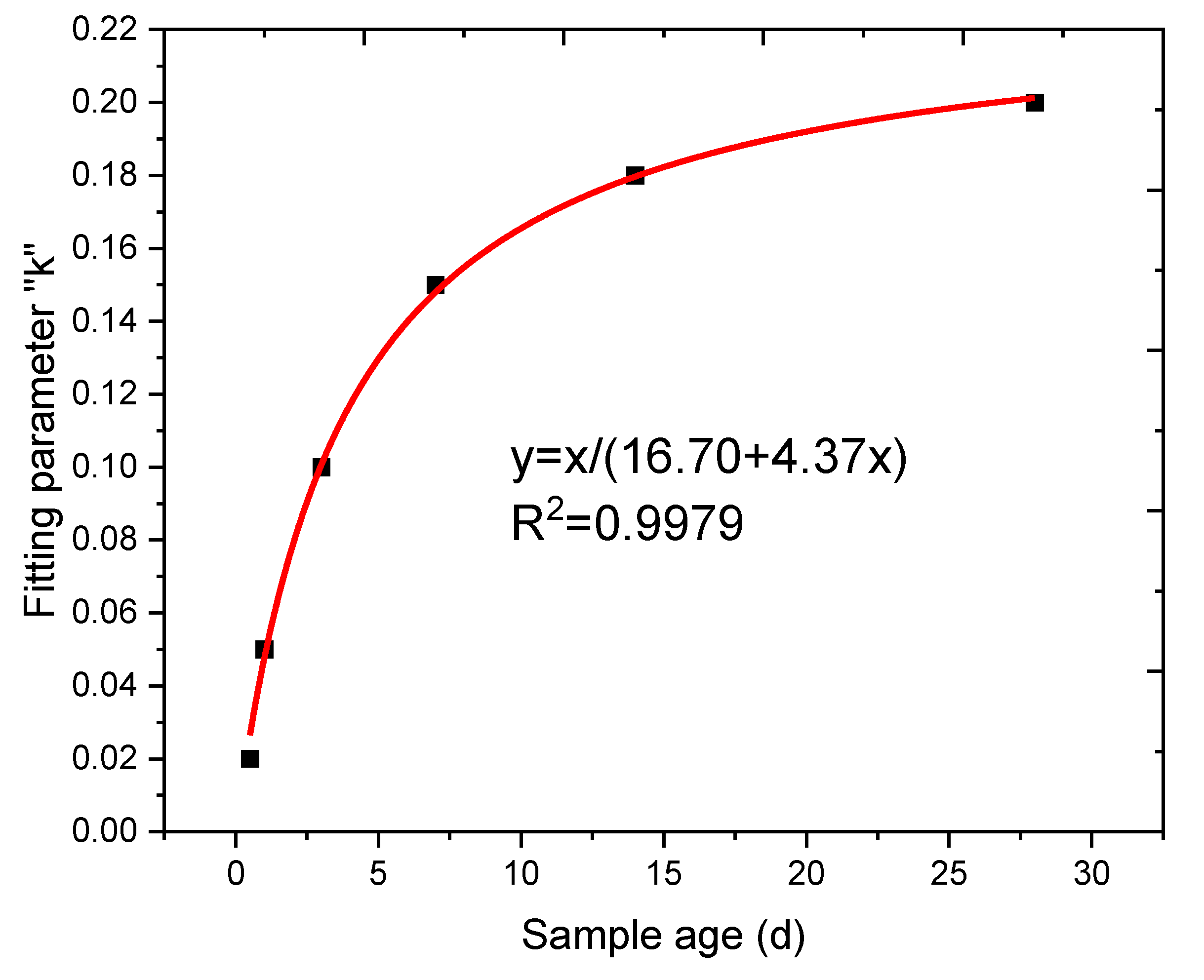

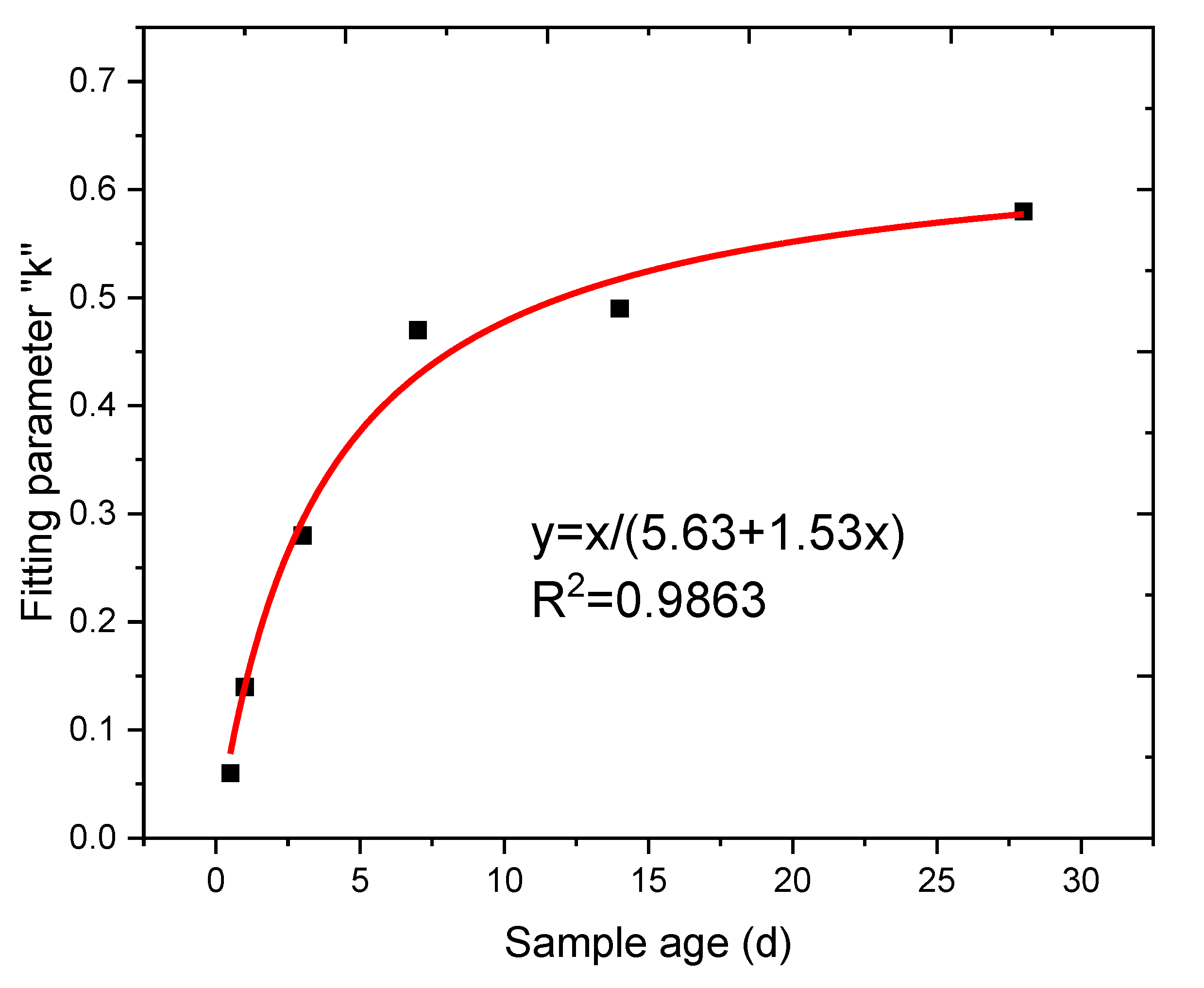


| CaO | SiO2 | Al2O3 | Fe2O3 | MgO | SO3 | K2O | Na2O | LoI | Fineness (m2/kg) |
|---|---|---|---|---|---|---|---|---|---|
| 64.47 | 20.87 | 4.87 | 3.69 | 2.13 | 2.52 | 0.65 | 0.11 | 0.77 | 368.9 |
| Length (mm) | 6 | Diameter (μm) | 18~48 |
| Tensile strength (MPa) | ≥450 | Elongation at break (%) | 1 |
| Young’s modulus (GPa) | ≥3.5 | Burning point (°C) | 590 |
| Density (g/cm3) | 0.91 | Melting point (°C) | 165~175 |
| Fiber Content (%) | Loading Speed (kN/s) | Sample Age (Days) | |||||||||||
|---|---|---|---|---|---|---|---|---|---|---|---|---|---|
| 0.5 | 1 | 3 | 7 | 14 | 28 | ||||||||
| fc,ave | ff,ave | fc,ave | ff,ave | fc,ave | ff,ave | fc,ave | ff,ave | fc,ave | ff,ave | fc,ave | ff,ave | ||
| 0 | 0.3 | 6.52 | 6.30 | 26.36 | 26.22 | 50.76 | 50.61 | 69.32 | 69.11 | 83.71 | 83.33 | 100.00 | 100.00 |
| 0.6 | 6.49 | 6.51 | 26.20 | 26.23 | 50.55 | 50.49 | 69.00 | 69.23 | 83.39 | 83.43 | 100.00 | 100.00 | |
| 1.0 | 6.50 | 6.58 | 26.19 | 26.13 | 50.35 | 50.56 | 69.23 | 72.74 | 83.22 | 83.46 | 100.00 | 100.00 | |
| 0.5 | 0.3 | 6.51 | 6.39 | 26.21 | 26.15 | 50.56 | 50.50 | 69.52 | 69.26 | 83.27 | 83.23 | 100.00 | 100.00 |
| 0.6 | 6.53 | 6.41 | 26.17 | 26.21 | 50.54 | 50.68 | 69.31 | 69.32 | 83.39 | 83.30 | 100.00 | 100.00 | |
| 1.0 | 6.49 | 6.65 | 26.19 | 26.25 | 50.52 | 50.65 | 69.07 | 69.32 | 83.51 | 83.36 | 100.00 | 100.00 | |
| 1.0 | 0.3 | 6.47 | 6.45 | 26.22 | 26.17 | 50.55 | 50.59 | 69.45 | 69.34 | 83.27 | 83.40 | 100.00 | 100.00 |
| 0.6 | 6.47 | 6.45 | 26.18 | 26.19 | 50.53 | 50.66 | 69.26 | 69.26 | 83.39 | 83.30 | 100.00 | 100.00 | |
| 1.0 | 9.53 | 6.51 | 26.50 | 26.22 | 51.18 | 50.45 | 69.02 | 69.26 | 83.16 | 83.36 | 100.00 | 100.00 | |
| Fiber Content (%) | Loading Speed (kN/s) | Sample Age (Days) | |||||||||||
|---|---|---|---|---|---|---|---|---|---|---|---|---|---|
| 0.5 | 1 | 3 | 7 | 14 | 28 | ||||||||
| fc | ff | fc | ff | fc | ff | fc | ff | fc | ff | fc | ff | ||
| 0 | 0.6 | 2.33 | 6.45 | 2.01 | 3.10 | 2.24 | 2.81 | 2.19 | 3.24 | 2.26 | 3.17 | 2.65 | 3.05 |
| 1.0 | 8.14 | 12.90 | 7.61 | 7.75 | 7.46 | 8.03 | 8.20 | 13.82 | 7.69 | 8.29 | 8.33 | 8.13 | |
| 0.5 | 0.6 | 3.43 | 3.13 | 2.84 | 3.05 | 2.94 | 3.16 | 2.67 | 2.88 | 3.13 | 2.88 | 2.97 | 2.79 |
| 1.0 | 8.00 | 12.50 | 8.09 | 8.40 | 8.09 | 8.30 | 7.49 | 8.07 | 8.48 | 8.15 | 8.18 | 7.98 | |
| 1.0 | 0.6 | 2.81 | 3.03 | 2.77 | 2.99 | 2.88 | 3.09 | 2.62 | 2.82 | 3.06 | 2.81 | 2.91 | 2.93 |
| 1.0 | 58.99 | 9.09 | 9.15 | 8.21 | 9.35 | 7.72 | 7.33 | 7.89 | 7.86 | 7.96 | 8.00 | 8.01 | |
| Loading Speed (kN/s) | Fiber Content (%) | Sample Age (Days) | |||||||||||
|---|---|---|---|---|---|---|---|---|---|---|---|---|---|
| 0.5 | 1 | 3 | 7 | 14 | 28 | ||||||||
| fc | ff | fc | ff | fc | ff | fc | ff | fc | ff | fc | ff | ||
| 0.3 | 0.5 | 1.74 | 3.23 | 1.29 | 1.55 | 1.49 | 1.61 | 2.19 | 2.06 | 1.36 | 1.71 | 1.89 | 1.83 |
| 1.0 | 3.49 | 6.45 | 3.59 | 3.88 | 3.73 | 4.02 | 4.37 | 4.41 | 3.62 | 4.15 | 4.17 | 4.07 | |
| 0.6 | 0.5 | 2.84 | 0.00 | 2.11 | 1.50 | 2.19 | 1.95 | 2.67 | 1.71 | 2.21 | 1.42 | 2.21 | 1.58 |
| 1.0 | 3.98 | 3.03 | 4.37 | 3.76 | 4.38 | 4.30 | 4.81 | 3.99 | 4.42 | 3.78 | 4.43 | 3.94 | |
| 1.0 | 0.5 | 1.61 | 2.86 | 1.74 | 2.16 | 2.08 | 1.86 | 1.52 | −3.10 | 2.10 | 1.58 | 1.75 | 1.69 |
| 1.0 | 52.15 | 2.86 | 5.07 | 4.32 | 5.56 | 3.72 | 3.54 | −1.03 | 3.78 | 3.83 | 3.85 | 3.95 | |
| Source | Model |
|---|---|
| ACI 209 [38] | |
| CEB-FIP [39] | |
| GL 2000 [40] |
Publisher’s Note: MDPI stays neutral with regard to jurisdictional claims in published maps and institutional affiliations. |
© 2021 by the authors. Licensee MDPI, Basel, Switzerland. This article is an open access article distributed under the terms and conditions of the Creative Commons Attribution (CC BY) license (http://creativecommons.org/licenses/by/4.0/).
Share and Cite
Chen, H.; Huang, X.; He, R.; Zhou, Z.; Fu, C.; Wang, J. Mechanical Properties of Polypropylene Fiber Cement Mortar under Different Loading Speeds. Sustainability 2021, 13, 3697. https://doi.org/10.3390/su13073697
Chen H, Huang X, He R, Zhou Z, Fu C, Wang J. Mechanical Properties of Polypropylene Fiber Cement Mortar under Different Loading Speeds. Sustainability. 2021; 13(7):3697. https://doi.org/10.3390/su13073697
Chicago/Turabian StyleChen, Hui, Xin Huang, Rui He, Zhenheng Zhou, Chuanqing Fu, and Jiandong Wang. 2021. "Mechanical Properties of Polypropylene Fiber Cement Mortar under Different Loading Speeds" Sustainability 13, no. 7: 3697. https://doi.org/10.3390/su13073697
APA StyleChen, H., Huang, X., He, R., Zhou, Z., Fu, C., & Wang, J. (2021). Mechanical Properties of Polypropylene Fiber Cement Mortar under Different Loading Speeds. Sustainability, 13(7), 3697. https://doi.org/10.3390/su13073697







